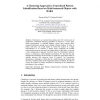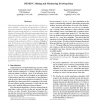80 search results - page 9 / 16 » Clustering in a Multi-Agent Data Mining Environment |
IJCNN
2008
IEEE
14 years 1 months ago
2008
IEEE
— Nowadays, huge amounts of information from different industrial processes are stored into databases and companies can improve their production efficiency by mining some new kn...
INFOVIS
2000
IEEE
13 years 12 months ago
2000
IEEE
A sequential pattern in data mining is a finite series of elements such as A → B → C → D where A, B, C, and D are elements of the same domain. The mining of sequential patte...
ILP
2005
Springer
14 years 1 months ago
2005
Springer
Clustering is a fundamental task in Spatial Data Mining where data consists of observations for a site (e.g. areal units) descriptive of one or more (spatial) primary units, possib...
ADBIS
2007
Springer
2007
Springer
Clustering Approach to Generalized Pattern Identification Based on Multi-instanced Objects with DARA
14 years 1 months ago
Clustering is an essential data mining task with various types of applications. Traditional clustering algorithms are based on a vector space model representation. A relational dat...
ICDE
2000
IEEE
14 years 8 months ago
2000
IEEE
Data mining algorithms have been the focus of much research recently. In practice, the input data to a data mining process resides in a large data warehouse whose data is kept up-...


